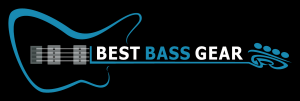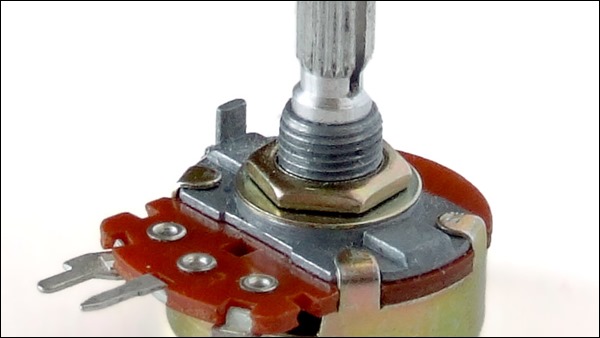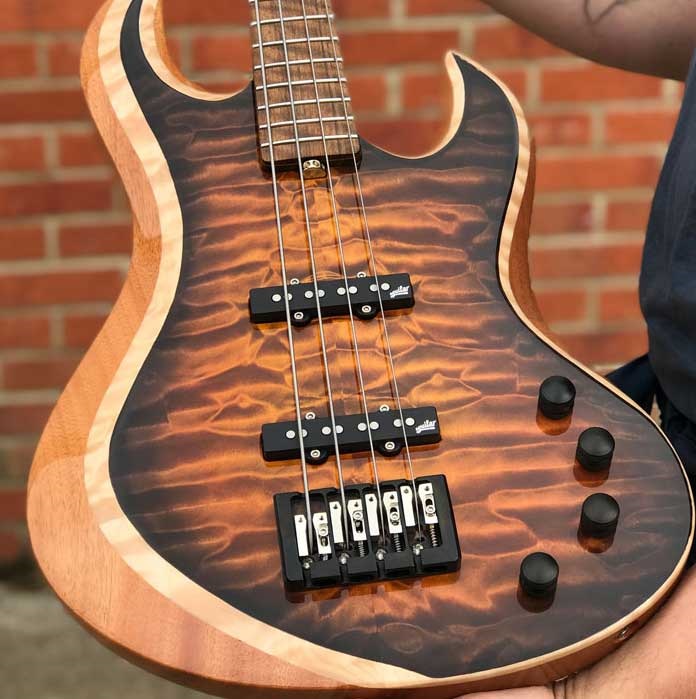Before beginning this one, know that there is no official rule that states you have to use a 250K audio taper potentiometer in your bass. It’s your bass, and you can use whatever you choose. However, there are reasons why this particular pot is used.
Also, bear in mind this is written from a passive electronics point of view. With a preamp installed, you have more options.
Another thing to bear in mind is that you have many different potentiometer options available. See for yourself.
A brief explanation of how pots work
A pot has a resistance value. The most common values for guitar pots are 250K and 500K, but there are several others such as 100K, 300K, 1000K (commonly known as 1meg,) and so on. The resistance value determines how much of the signal is bled to ground. The higher the value, the more treble you will hear.
A pot also has a taper. The taper is known as the “resistance-position relationship.” In guitars, there are two taper types that are used in guitars more than any other. Logarithmic, commonly known as an audio taper, and linear.
With a linear taper, treble cuts off quickly early in the turn of the knob. With an audio taper, the treble decreases much later in the turn.
250K is generally the most useful resistance value for a bass player
Many bass pickups sound best when connected to a 250K volume pot. At full volume, there is plenty of treble response that’s suitable for all playing styles. New strings sound great, old strings sound great, fret clack is there for slap style, and so on.
What would happen if you installed a 500K or greater volume pot?
You’ll get more treble response, but probably not the kind you would appreciate. It will be an “ice pick” like sound that’s harsh to the ears, even for something as simple as string drag noise when you move your fret hand from fret to fret.
An audio taper volume pot is the most useful for a bass player
For bass players, the audio taper volume pot is preferred because you get use out of almost the whole turn of the knob.
If you decided to use a linear taper pot for a volume control, treble decrease happens much sooner, so much to the point where only half of the turn would be usable to you. Possibly even less.
When would a linear taper pot prove to be more useful (if ever)?
As a volume control, linear is better for those that want treble cut off a lot sooner with minimal turn of the knob.
If you’ve been playing and ever thought to yourself, “I wish there were a way to cut off treble without having to turn the knob so much,” you may want to try out linear taper pots.
Do you have to “match” linear to linear, audio to audio?
No. If you want a linear taper volume and an audio taper tone control or vice versa, go for it.
In a practical sense however, linear/volume and audio/tone is more useful than audio/volume and linear/tone. A linear taper pot on the volume allows for quick treble cutoff since that’s the control you use more often anyway, and the audio taper pot on the control should have more of the turn available to you for smaller adjustments.




The rule of thumb is to use a pot value 40 times the DC resistance of the pickup.
That’s nonsense.
The real rule of thumb is “bright” (or ice pick) pickups sound good with 250K or lower, and “dark” (or muddy) pickups sound good with 500k or higher.
Ultimately there are no hard rules – experiment and let your ears be the judge.
You’ve got it wrong. Audio taper volume pots loose treble much earlier than linear. 500k linear pots are best for a Jazz style bass with two vols. and one tone, as the combined resistance is 250k and the volume taper is more gradual, so this gives more scope for blending the pickups.
Audio volume pots loose treble very early as you turn them down from full.
I’m pretty sure it’s the opposite as far as audio vs linear. I switched from audio to linear in my VVT P/J bass so I could blend the two pickups more efficiently. When I was using audio volumes, with both neck/and bridge all the way up, a very small adjustment on the neck volume and it’s all bridge. Switching those two volumes to linear gives you a much more usable range to blend and balance the two pickups together. Historically, 250k pots and audio taper was the traditional setup, but a lot more players are finding that in a VVT setup, linear volumes and an audio Tone is more useful. Cheers.
Marked URGENT!
I’m rebuilding an early 2 x Humbucker Yamaha. Mini pots broke a couple years ago. I have 2 MM Humbuckers 12k ohms each. I want to build my own wiring harness and I been building P bass rigs for myself for 15 years, but here is the rub. I am a non techy hobbyist. Your disagreement only confuses me. I tend to buy parts I read are great then I read someone say something to the contrary? Now I’m getting/am old and at 72 building and dismantling becomes wearing and I spoil stuff. I just want to get this rig right! So here is whats on the bench.: All new/or NOS unused CTS 2 x 250k No Load Volumn Pots. 2 x 250k Audio ‘A’ Pots. 2 x 250k EP085? 1 x 250k EP885? 3 X 500k EP086. 4 x Fender Custom Shop 250k? ? = Audio or Linear Don’t Know? Audio used to mean Sound/Volumn when I was in the Army, now some people argue it means Tone.
Please give me your suggestions and explain why. Thank you all in advance. ziggy
There is no No Load for Volume only Tone. I totally understand where you’re coming from with your question in general, however and respectfully suggest that, at your age, using the highest value pots You have due to inevitable treble loss encountered by seniors
That being said, many instruments, exhibit fairly negligible differences in many components and pots can vary wildly from the printed tolerances anyway
Yes…….I agree that there is some sort of “CONFISION” here about Audio taper pots & Linear taper pots & where the treble cut starts……I’m assuming that it is meant that when the pot is turned completely “CLOCKWISE” [wide open] that this is where the CONFUSION starts. Which pot, Audio taper or Linear taper starts to roll of the treble “SOONER” ??
So which is it ???
Not all audio pots are the same, key word to all this is ‘Taper’. A linear pot has a 1:1 taper, the value you dial in is what you get out, but an audio taper is curved so the value put in is sqewed, the shape of the taper in an audio pot can vary, there’s at least six or seven different tapers available even from same manufacturer like CTS and they will affect how the tone or volume reacts across the dials range.
I have an SX bass, yes nice and cheap, but I like the neck and the swamp ash body. I do all my recording etc at home so I don’t need to rack up the volume. Could I use vvt all linear pots. Would that give me more creativity as regards pick blending and tone. Its a bit of an ongoing project, and im having fun experimenting.
Cheers
Try it and see
YMMV but so might other people’s…
Gotta guildB302s four string electric bass guitar the S stands for stereo. Guess was factory option not many purchased. Very little info out there about it. Not collector anymore think it’s late 1970s .between 78though83 bass older than most hottygurls kick it with. Yet at 48 learnt hard way more to relationships than bedroom anyway going sell this bass get five string jag. Bass I’m in Colorado here my email give ya phone number from there joeowens440@gmail.com whole Bass original encluding the case
People throw that word “linear” around a lot, and many don’t know what it means. I recommend “Electric Guitar Amplifier Handbook” by Jack Darr. Volume and tone circuits used in guitars AND amplifiers are explained and demystified in this fantastic book. Buy it today. Find an early edition (small format, black cover) if you can, the later version, which is larger and has a green cover, has a lot of solid-state stuff in it that nobody cares about.
You can go all audio taper pots and have no worries. Linear volume is a preference some people hold as gospel. Honestly, most people can’t tell the difference – especially if you’re sculpting your sound with pedals and a quality amp.
The choices are really:
1) all audio taper pots
2) linear volume pots and audio tone pots
If you really care about the quality, buy only pots (CTS or Bourns) with a stated 10% tolerance. THAT factor actually makes a big difference.